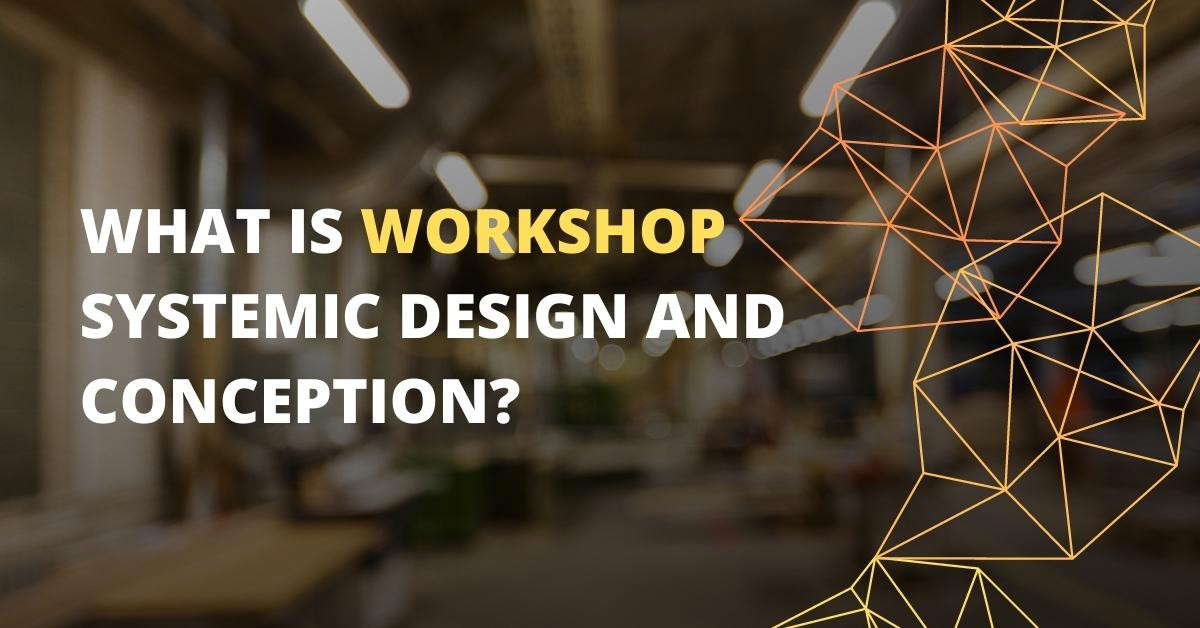
Overview of Group Decision-Making
Systemic Conversation Management in Group Decision-Making
Benefits of Systemic Conversation Management
Challenges of Systemic Conversation Management
Best Practices for Group Decision-Making with Systemic Conversation Management
Group decision-making is a complex process involving the collective efforts of multiple people and can significantly impact the outcome of a decision. Effectively managing conversations among all participants is essential to ensure that all voices are heard and that the best decision is reached. Systemic conversation management provides a framework for groups to effectively manage their conversations and ensure everyone's ideas and perspectives are considered.
Overview of Group Decision-Making
When making decisions in groups, it is essential to consider the collective opinion of all participants. Group decision-making is a complex process and requires the coordination of multiple people to reach an agreement. Therefore, it is essential to consider all opinions and perspectives of the group and the context of the decision-making process. Additionally, the group should strive to reach a consensus that all participants feel is fair and equitable.
Systemic Conversation Management in Group Decision-Making
Systemic conversation management is a framework for effectively managing group conversations in decision-making processes. It is a process of setting ground rules and expectations for the discussion, ensuring everyone's perspectives are heard and that all participants are involved. As a result, systemic conversation management helps ensure everyone's voices are heard, and the best decision is reached.
Benefits of Systemic Conversation Management
Systemic conversation management provides numerous benefits to groups engaging in decision-making processes. It helps ensure that everyone's ideas and perspectives are considered and provides a safe and supportive environment for conversations. It also helps ensure that all participants are engaged in the conversation and that the best decision is reached.
Challenges of Systemic Conversation Management
Despite its numerous benefits, systemic conversation management can present particular challenges to groups engaging in decision-making processes. It is essential to ensure that all participants are comfortable with the process and that everyone's perspectives are heard and respected. Additionally, ensuring that the conversation remains focused on the task at hand and that all participants are on the same page can be challenging.
Best Practices for Group Decision-Making with Systemic Conversation Management
When engaging in group decision-making with systemic conversation management, a few best practices should be followed:
It is essential to set clear expectations for the conversation and ensure that all participants understand what is expected of them.
Ensuring that all participants are comfortable with the process and that their ideas and perspectives are heard and respected is essential.
Ensuring that the conversation remains focused on the task and that all participants are on the same page is essential.
Ensuring that all participants' decision-making process is fair and equitable is essential.
In conclusion, group decision-making is a complex process that requires the collective effort of multiple people to reach a consensus. Systemic conversation management provides a framework for managing conversations among all participants and ensuring everyone's ideas and perspectives are considered. Additionally, a few best practices should be followed when engaging in group decision-making with systemic conversation management, such as setting clear expectations, ensuring everyone is comfortable with the process, and ensuring the decision-making process is fair and equitable.
The strength of a group lies in its ability to manage conversations and make decisions together effectively.
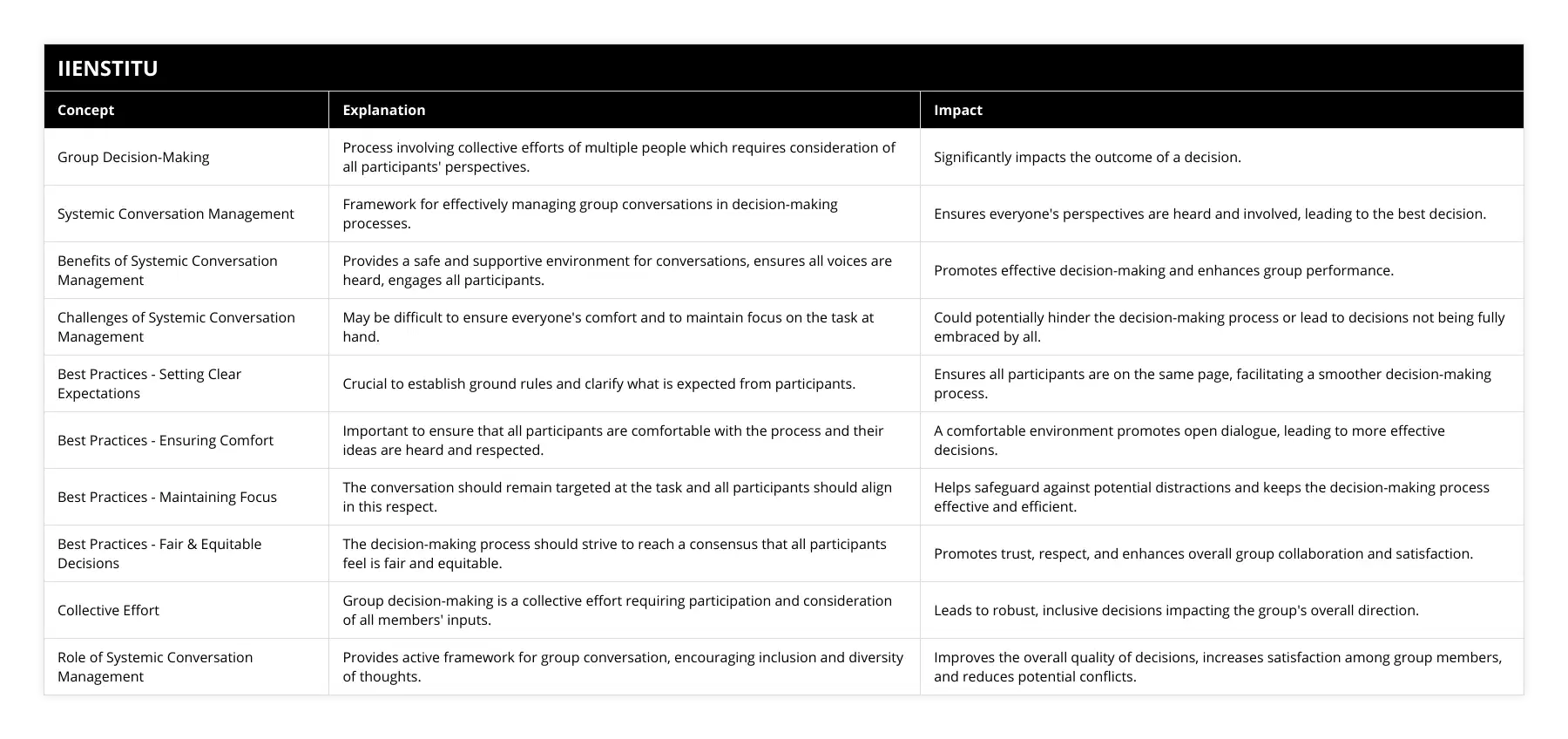
Frequently Asked Questions
What is Group Decision-Making?
Group decision-making is creating a collective decision within a group of individuals. It involves various aspects such as communication, cooperation, problem-solving, and consensus-building. Group decision-making aims to make decisions that benefit the entire group and ensure that all members have an equal say in the process.
Group decision-making can be used in many contexts, from business meetings to family gatherings. It is an essential tool for organizations to ensure that everyone involved in the decision-making process has an equal voice and that their ideas are considered. Group decision-making also encourages collaboration and problem-solving among team members, which can lead to better outcomes than if a single individual was responsible for making decisions on their own.
Group decision-making generally involves two primary components: brainstorming and voting. During the brainstorming stage, each group member will propose different ideas or solutions, which the entire group will discuss. This discussion may involve debating various points or discussing potential pros and cons associated with each idea. Once all opinions have been heard, voting can determine which solution is best for the group.
When done correctly, group decision-making can lead to better decisions than those made by an individual alone because it allows for multiple perspectives and ideas to be considered before making a final choice. Additionally, it encourages collaboration between team members, which can help create innovative solutions that would not have been discovered otherwise. On the other hand, if done poorly, it can lead to disagreements among stakeholders or, even worse - apathy toward making progress!
In conclusion, group decision-making is a powerful tool for organizations and teams because it allows multiple perspectives to be considered when making decisions that lead to better outcomes than relying on one individual’s opinion alone. Furthermore, it promotes collaboration between team members, which helps generate innovative solutions that could not be discovered as easily by one working alone. Finally, by adequately utilizing this strategy, organizations can benefit significantly from improved productivity levels due to increased stakeholder participation during any project or task!

What is Systemic Conversation Management?
Systemic Conversation Management is a concept that has gained traction in communication over the last few years. It is a way of organizing conversations within an organization to increase the efficiency and effectiveness of communication. The idea is that organizations can better understand the flow of information by using a system to manage conversations and identify areas where communication is lacking or could be improved.
At its core, Systemic Conversation Management is about understanding how conversations take place within an organization and how to manage them better. This involves identifying the key stakeholders involved in the conversation, the topics discussed, the timing, and the conversation's format. By understanding these elements, organizations can better anticipate topics, plan for conversations, and ensure that the most important topics are discussed promptly.
One of the critical benefits of Systemic Conversation Management is that it allows an organization better to understand the flow of information within an organization. As a result, organizations can better anticipate topics and plan conversations by understanding the conversations that take place. This can help reduce misunderstandings and ensure that the most important topics are discussed promptly.
In addition, Systemic Conversation Management can also help organizations identify areas where communication could be improved. By understanding the conversations and topics discussed, organizations can better identify areas where communication could be improved. This can help organizations become more efficient and effective in their communications.
In conclusion, Systemic Conversation Management is an important concept that can help organizations become more efficient and effective in their communications. By understanding the conversations and topics discussed, organizations can better anticipate topics, plan conversations, and identify areas where communication could be improved. In doing so, organizations can become more efficient and effective in their communications.
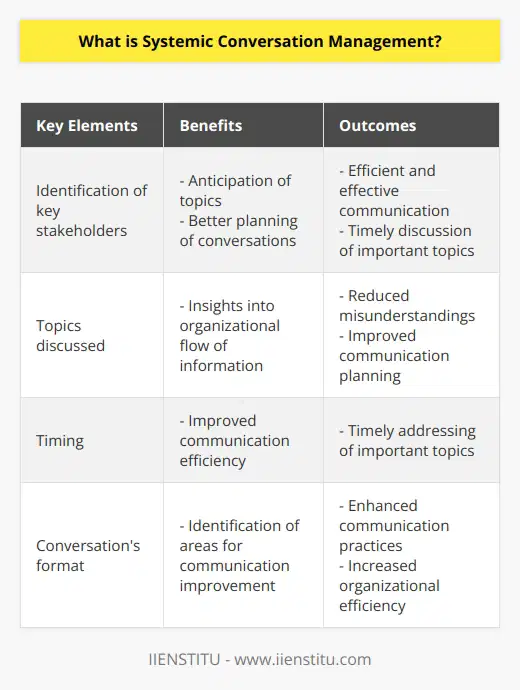
What are the Benefits of Systemic Conversation Management?
Systemic conversation management is becoming increasingly popular among businesses and organizations to facilitate communication and collaboration. This approach to managing conversations focuses on the structure, organization, and dynamics of conversations to create an environment that encourages the productive exchange of ideas and information. In this article, we will discuss the benefits of systemic conversation management in further detail.
The most salient benefit of systemic conversation management is that it offers improved communication clarity. By ensuring that conversations are organized according to predetermined structures, individuals can more easily keep track of their contributions and those made by others. Additionally, this approach can help prevent irrelevant tangents from derailing the discussion at hand, allowing for more efficient communication between parties involved in the dialogue.
A second benefit associated with systemic conversation management is increased efficiency in problem-solving. By instituting a structure for conversations that ensures all perspectives are heard and discussed thoroughly, decision-making processes become much more effective and streamlined. This reduces delays in arriving at solutions and allows for greater creativity during problem-solving since all voices are considered equally during deliberations.
Finally, systemic conversation management has been shown to facilitate deeper understanding between parties involved in conversations through improved participant listening skills. Teaching individuals how to be better listeners – through techniques such as actively paraphrasing what has been said – makes it easier to comprehend what is being communicated and identify areas where additional clarification may be needed. This allows everyone involved to develop a more nuanced understanding of any given topic or issue being discussed, which can lead to a more effective resolution of disagreements or conflicts between parties engaged in dialogue.
In conclusion, systemic conversation management offers numerous advantages in improving communication within an organization or business setting. Through structured dialogue that encourages clarity and efficiency when discussing topics or issues, this approach helps ensure that exchanges remain productive while enabling all parties involved to better understand any given topic under consideration through improved listening skills among participants.

What is group decision making in management?
Group Decision Making in Management
Definition and Importance:
Group decision making in management refers to the process of collaboratively solving problems, making choices, or determining courses of action among multiple individuals within an organization. This collective approach draws on the diverse expertise, perspectives, and resources present in a group, often resulting in more informed, creative, and effective solutions than those reached by individuals acting alone.
Steps in Group Decision Making:
Identify the Problem or Opportunity
The group collectively defines the issue that requires a decision, ensuring that all members have a shared understanding of the situation at hand.
Gather and Analyze Information
Members gather relevant data, facts, and expert opinions, then analyze and share this information to develop a comprehensive understanding of the issue and potential solutions.
Brainstorm and Develop Alternatives
The group generates a wide range of possible solutions, fostering creative thinking and open discussion to arrive at a diverse set of options.
Evaluate Options and Choose the Best Solution
Members assess and compare the proposed alternatives, considering the consequences, risks, and feasibility of each option, and then collectively choose the most promising solution.
Implement and Monitor the Decision
The group develops an actionable plan for implementing the chosen solution and monitors its progress, adjusting the approach as needed to ensure success.
Benefits of Group Decision Making:
Inclusion and Diversity
Involving multiple individuals in the decision-making process encourages diverse perspectives, experiences, and expertise, which can lead to more innovative and effective solutions.
Increased Commitment and Ownership
Group members are more likely to support and take responsibility for implementing solutions they have been actively involved in developing.
Enhanced Learning and Skill Development
Working collaboratively on decision making allows individuals to learn from one another, building relationships and acquiring new skills that can enhance their overall performance within the organization.
Challenges and Solutions:
Despite the numerous benefits, group decision making in management can also present challenges, such as groupthink, conflict, and inefficiencies. Organizations can address these challenges by promoting open communication, encouraging diverse viewpoints, establishing clear decision-making processes, and providing training and support to enhance collaborative skills. By overcoming these obstacles, organizations can unlock the full potential of group decision making to drive growth, innovation, and success.

What are the three group decision making techniques?
Group Decision-Making Techniques
One effective method for facilitating group decision-making is the Nominal Group Technique (NGT). NGT involves generating ideas in a structured manner, where everyone has an equal opportunity to participate, reducing the dominance of more assertive group members. Participants first write down their ideas independently, and then the ideas are shared and discussed as a group. Finally, everyone prioritizes the ideas through a voting process, ensuring that the decision reflects the group's collective opinion.
Another widely used technique is the Delphi Method, which seeks to achieve consensus among a larger group of experts who participate remotely. The Delphi Method involves an iterative process where anonymous questionnaires are sent to experts, and their responses are collected, analyzed, and shared. Experts then have the opportunity to revise their views based on their peers' opinions, and this process is repeated until a consensus is reached. The anonymity of the method allows participants to provide unbiased opinions, while the iterative process allows them to learn from each other.
Lastly, the Stepladder Technique is useful in smaller groups where face-to-face interaction is desired. The process begins with a pair of group members discussing the decision and agreeing on their preferred option. Then, a third member joins the discussion, presents their opinion, and the group reaches a new consensus. This pattern continues until all members have participated and evaluated their options. The Stepladder Technique encourages individual input and minimizes the risk of groupthink, as participants' opinions are valued before they are influenced by the larger group.
In conclusion, the Nominal Group Technique, Delphi Method, and Stepladder Technique are three useful methods for facilitating group decision-making. By following these strategies, groups can find solutions that reflect the diverse opinions of their members, improving the quality of the decisions and the satisfaction of the participants.
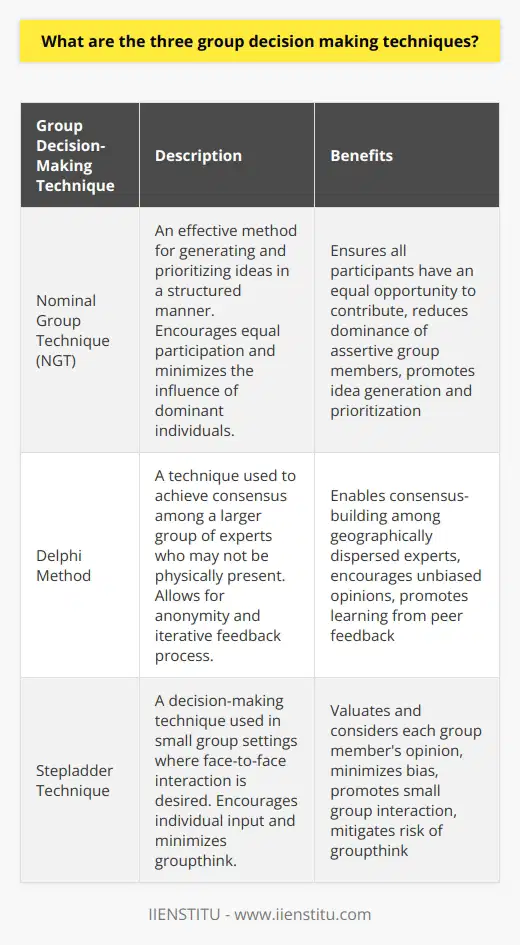
What is the decision-making process in group communication?
Role of Group Communication
The decision-making process in group communication primarily relies on the effective exchange of information and coordinated efforts of group members. Group communication plays a critical role in achieving successful decision-making, as members bring together diverse perspectives, experiences, and expertise to evaluate different alternatives and deliberate on the best course of action.
Collective Intelligence and Shared Understanding
Collective intelligence emerges from the collaborative efforts of group members, which enhances the quality of decision-making. As they share information and ideas, members create a shared understanding of the issues at hand. This process of collective sensemaking fosters critical thinking amongst the group, enabling a more comprehensive evaluation of options.
Negotiation and Conflict Resolution
In group decision-making, differences of opinion and conflicts are inevitable. Group communication provides a structured environment for members to negotiate differing views and aims for conflict resolution. Through constructive dialogue and effective listening, group members can address concerns and clarify misunderstandings, enabling them to reach a mutually agreed-upon decision.
Collaborative Decision-Making Methods
Group decision-making methods, such as brainstorming, nominal group technique, and consensus-building, are integral components of the group communication process. These methods facilitate idea generation, organization, and evaluation, ultimately contributing to the formulation of well-informed decisions.
Feedback Mechanism and Reflection
Effective group communication incorporates feedback mechanisms to ensure continuous improvement in decision-making. Members can provide both verbal and non-verbal feedback, and are encouraged to reflect on the process and outcomes. This feedback allows the group to refine their decision-making strategies, ensuring that they remain adaptable and responsive to changing circumstances.
In conclusion, the decision-making process in group communication relies on various aspects of collaborative interaction and engagement. By fostering collective intelligence, enabling negotiation and conflict resolution, employing structured decision-making methods, and incorporating a feedback mechanism, group communication plays an essential role in making well-informed decisions.

What are different group decision-making techniques?
Group Decision-Making Techniques
Brainstorming Technique
One widely used technique for group decision-making is brainstorming, which encourages the generation of numerous ideas by all team members without judgment or criticism. The brainstorming process typically involves a facilitator guiding the conversation, ensuring everyone's participation, and promoting a safe, open atmosphere.
Nominal Group Technique
Another popular method is the nominal group technique, which is particularly effective in ensuring equal participation within groups. Participants individually list their ideas before discussing and clarifying them as a group. Subsequently, everyone ranks the ideas through a secret ballot, allowing the group to identify and prioritize the best ideas and reach consensus.
Delphi Technique
The Delphi technique is a structured communication approach, useful for making decisions in situations where face-to-face meetings are not possible. Participants anonymously answer a series of questionnaires, and their responses are summarized and redistributed for further input. The process repeats until a consensus emerges, safeguarding participants from the influence of dominant personalities and encouraging unbiased opinions.
Multi-voting Technique
Multi-voting, also known as the dotmocracy method or sticker voting, is useful for identifying the most popular ideas from a large list. Each participant is given equal votes, which they can freely distribute among the ideas, either equally or disproportionately. The ideas with the most votes are then prioritized and discussed further.
Stepladder Technique
The stepladder technique is designed to prevent groupthink and promote individual contribution by introducing participants to the decision-making process in a stepwise manner. Initially, only two participants discuss the issue at hand before a third joins, contributing their ideas without influence from the pre-existing conversation. This process continues until all members have joined, fostering independent thinking and diverse opinions.
Consensus-Based Decision Making
Consensus-based decision making aims to foster agreement among team members, rather than relying on majority votes. By actively discussing individual opinions, concerns, and suggestions, the group focuses on creating a shared understanding of the problem and generating collective solutions. This method can be time-consuming but produces decisions that are more likely to be supported and implemented by all members.
In conclusion, various group decision-making techniques are available to suit different contexts and group dynamics. By selecting an appropriate method, groups can foster collaboration, creativity, and diverse perspectives – ultimately making more effective and informed decisions.
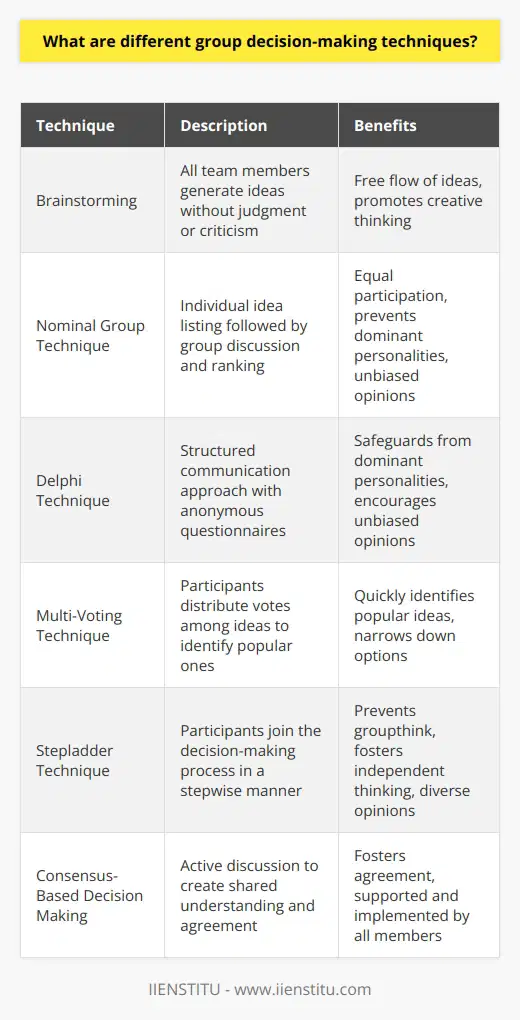
How can group decision-making improve overall management strategies?
Enhanced Management Strategies Through Group Decision-Making
Incorporating Diverse Perspectives
Group decision-making can significantly enhance overall management strategies by incorporating diverse perspectives and experiences. In a group setting, individuals bring their unique insights to the table, which encourages an open exchange of ideas and a robust discussion. This collective process leads to more comprehensive decisions, foreseeing potential problems and identifying innovative solutions.
Promoting Creative Solutions
Another advantage of group decision-making is its potential to generate creative solutions through brainstorming and collaborative thinking. When multiple minds come together, they can explore a variety of alternatives in a dynamic manner, leading to innovative outcomes. This creative process helps organizations stay ahead of their competitors and develop unique management strategies that redefine industry standards.
Ensuring Inclusive Decision-making
Group decision-making is also beneficial due to the inclusive nature of the process. It ensures that every team member's input is considered in the final outcome, thus fostering a sense of ownership and commitment. This collective decision-making approach empowers employees, leading to stronger buy-in and improved morale. When employees feel included in the decision-making process, they are more likely to invest their energy in the successful implementation of management strategies.
Minimizing Risks and Biases
Considering multiple perspectives through group decision-making minimizes the risks of individual biases and errors. The shared responsibility in decision-making reduces the likelihood of information gaps and oversight, promoting better risk management. Additionally, because group members bring diverse backgrounds and expertise, they can evaluate situations from different angles, reducing potential blind spots and improving overall decision quality.
Fostering a Participatory Environment
Finally, group decision-making fosters a participatory environment that strengthens organizational culture. By involving employees in important decisions, management promotes a sense of unity and collaboration throughout the organization. This participatory approach encourages open communication and trust, which are essential components for creating a resilient and high-performing workforce.
In conclusion, group decision-making presents a valuable approach to enhance overall management strategies by incorporating diverse perspectives, promoting creative solutions, ensuring inclusive participation, minimizing risks and biases, and fostering a collaborative environment. Implementing this approach can significantly improve an organization's ability to innovate, adapt, and succeed in today's competitive business landscape.

In what ways does the decision-making process in group communication impact the effectiveness of a team?
The Impact of Group Decision-Making
The decision-making process in group communication significantly impacts the effectiveness of a team. This is attributed to several factors: the quality of information sharing, the group's cohesion, and the avoidance of groupthink.
Information Sharing Quality
Decisions become more informed and beneficial when team members share their knowledge, opinions, and ideas. Effective communication generates a diversity of perspectives, which can foster better decision-making. When a team successfully shares accurate and relevant facts, it not only enhances decision quality but also supports individuals' personal growth.
Group Cohesion
Team effectiveness is positively influenced by a sense of unity and shared purpose among members. Effective decision-making through group communication strengthens both emotional and working relationships. These strong bonds drive team members to work collaboratively, helping them obtain joint success. Moreover, this cohesion encourages accountability and motivation, as members realize that their decisions are important in achieving the goals of the whole team.
Avoiding Groupthink
Group decision-making, however, is not without its risks. One of these risks is groupthink - when team members prioritize conformity and harmony over critical examination of ideas. This can result in poor decision-making and a diminished team performance. Therefore, teams must strive to cultivate an environment of open communication, where diverse opinions are valued, and thoughtful disagreements are encouraged. This fosters constructive debate, reducing the likelihood of groupthink and enhancing the effectiveness of a team.
In conclusion, the decision-making process in group communication plays a crucial role in shaping the effectiveness of a team. The quality of information sharing, group cohesion, and the avoidance of groupthink all contribute to a team's overall performance. By promoting open communication and valuing diverse perspectives, teams can enhance their decision-making abilities and ultimately attain success.
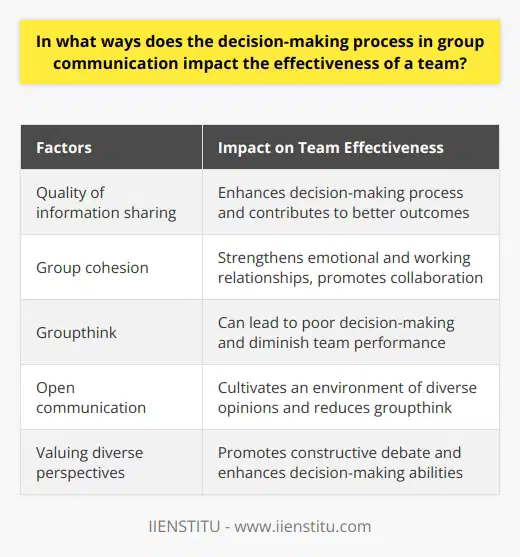
What is the importance of group decision making in management?
Significance of Group Decision Making
In contemporary management practices, group decision making has emerged as a pivotal tool in achieving organizational goals. One reason for its increased importance is the recognition of diverse perspectives, which fosters a comprehensive understanding of an issue. The collaborative process allows pooling of knowledge and experience from various team members, providing exposure to unconventional approaches and fostering creativity.
Enhancing Decision Quality
Group decision making plays a critical role in improving the quality of managerial decisions. Considering multiple perspectives and arguments reduces the likelihood of overlooking essential factors that may affect the organization. As a result, the decision becomes more informed and robust, minimizing the chances of unfavorable outcomes. Furthermore, as team members actively engage in healthy discussions, they generate innovative ideas, which lead to improved strategies and long-term growth.
Promoting Commitment and Ownership
When employees participate in the decision-making process, they feel a sense of ownership and commitment to the choices made. This active involvement has proven to enhance motivation and job satisfaction, subsequently leading to improved productivity and performance. Moreover, when decisions are made collaboratively, team members are more likely to accept and support the final outcome, facilitating smooth implementation of strategies.
Strengthening Team Building
Group decision making in management also aids in team building by facilitating communication among team members. As they interact with each other, employees develop trust and mutual understanding, team spirit is fostered, and interpersonal relationships are enhanced. These factors not only lead to a positive work environment but also contribute to seamless integration of diverse skills, leading to improved project delivery and overall organizational efficiency.
Mitigating Cognitive Biases
In managerial practices, it is crucial to mitigate the impact of cognitive biases that may impair decision making. Group decision making helps in addressing personal biases and assumptions, as various perspectives can challenge and objectively evaluate each other's thoughts. Collective wisdom often outweighs individual opinions, creating a balanced approach and minimizing the influence of potential cognitive biases.
Conclusion
In conclusion, group decision making is crucial in management as it enriches the quality of decisions, promotes commitment and ownership among team members, strengthens team building, and mitigates cognitive biases. Given these advantages, it is of utmost importance for organizations to recognize and encourage group decision making to achieve optimal outcomes and sustain growth in the competitive business landscape.
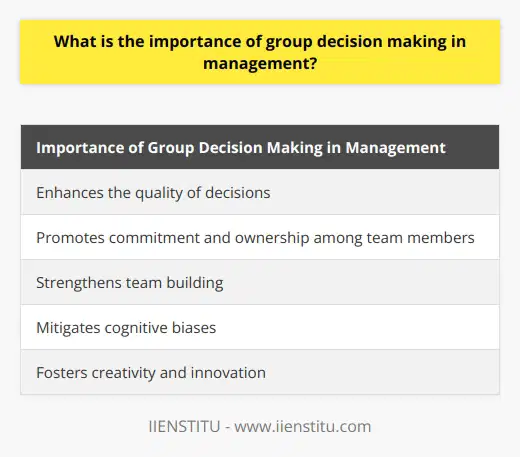
How can cultural diversity influence group decision making techniques?
Impact of Cultural Diversity on Decision Making Techniques
Cultural diversity in a group can greatly influence decision-making techniques, as individuals with different backgrounds and perspectives contribute unique ideas and approaches to solving problems.
Effects on Creativity and Innovation
Culturally diverse groups often exhibit higher levels of creativity and innovation than homogenous groups, as the blending of various cultures and experiences can generate novel ideas and solutions to issues. The ability to incorporate these diverse opinions and approaches can lead to more effective decision-making processes and better outcomes for the group as a whole.
Enhanced Communication and Collaboration
In order to benefit from the diverse perspectives within a group, it is essential to establish effective communication and collaboration techniques. This may involve accommodating differences in communication styles, finding common ground, and fostering an inclusive environment where all members feel comfortable sharing their ideas and opinions.
Potential Challenges and Ways to Overcome Them
Despite the many advantages that cultural diversity can bring to group decision-making, it may also present some challenges. These may include misunderstandings due to language barriers, differences in values and cultural norms, or conflicts of interest. To address these challenges, group members can partake in cultural awareness training to better understand and respect one another's backgrounds and perspectives. Furthermore, establishing clear roles, responsibilities, and decision-making processes can help mitigate potential conflicts and promote a more cohesive and productive group dynamic.
In conclusion, cultural diversity can greatly influence and improve group decision-making techniques by fostering creativity, enhancing communication and collaboration, and challenging individuals to think critically and adapt to various perspectives. By acknowledging and addressing the potential challenges that can arise, culturally diverse groups can harness the power of their collective experiences and insights to achieve more effective and well-rounded decision-making processes.
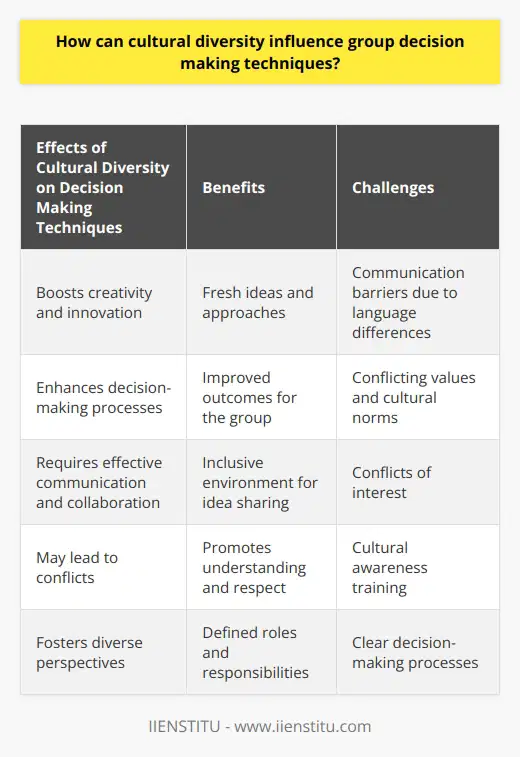
What are the potential challenges and limitations of group decision making in management?
Challenges in Group Decision Making
Diverse Opinions and Conflicts
A significant challenge in group decision making is managing the diverse opinions and conflicts that may arise. Individuals have their own perspectives and ideas, and disagreements can hamper decision-making effectiveness. Moreover, conflicts may escalate and affect team dynamics, causing factions to form, thus obstructing collaboration and consensus.
Social Pressure and Conformity
Group decision making often involves social pressure and conformity, where individuals may subdue their own opinions and conform to the majority viewpoint. This limits innovation and creativity, as unique and potentially valuable ideas can be suppressed. The desire to maintain group harmony can lead to suboptimal decisions, as dissenting opinions are not adequately explored.
Dominance of Vocal Members
In group settings, it is common for more vocal and assertive individuals to dominate discussions. This dominance may prevent less assertive members from expressing their ideas or concerns, which can result in an inadequate evaluation of alternative options. As a consequence, essential information may be overlooked, leading to poor decision outcomes.
Groupthink Phenomenon
Groupthink is a psychological phenomenon that may arise during group decision making, characterized by a collective desire for harmony, consensus, and cohesiveness at the expense of critical evaluation. Groupthink can lead to poor decisions, as divergent opinions and potential pitfalls are not adequately addressed. This can hold particularly severe consequences when high-stake decisions are involved in management settings.
Time Constraints and Inefficiencies
Group decision making can be time-consuming and inefficient, particularly when it involves extensive discussions and negotiations to reach a consensus. These processes can lead to delays in decision-making and may ultimately hinder the organization's ability to respond quickly to emerging challenges or opportunities.
Difficulty in Accountability
Decisions made by a group can lead to difficulties in assigning individual accountability. Group members can experience 'diffusion of responsibility,' where each member assumes that others in the group are responsible for outcomes. This can lessen the sense of ownership and commitment to the decision, potentially impacting the successful implementation of the chosen courses of action.
In conclusion, group decision making in management can pose numerous challenges, ranging from conflicts and social pressures to dominance issues and groupthink. While this process allows for greater diversity of opinions and shared responsibility, it is crucial to be aware of its inherent limitations to ensure effective decision outcomes.
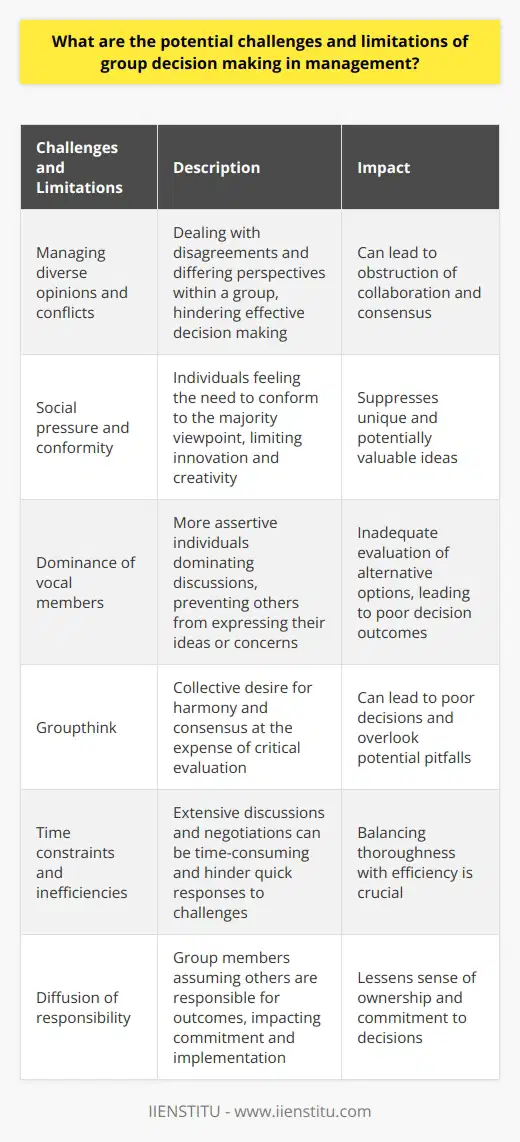
What factors contribute to the effectiveness of group decision making techniques in management?
Factors Contributing to Effective Group Decision-Making Techniques
Role Clarity in Groups
In group decision-making, it's essential to define and assign roles for better coordination and organization. This fosters accountability, enables effective communication, and reduces conflicts, thus enhancing the group's performance in decision-making tasks.
Skill Diversity and Knowledge Sharing
Group decision-making is more effective when members possess varying skills and expertise, allowing them to contribute unique perspectives towards the problem-solving process. Furthermore, knowledge sharing among group members is crucial to making informed decisions, as they can learn from each other's experiences and expertise.
Open Communication and Honest Feedback
Effective communication is a critical aspect of group decision-making. Members must openly share their ideas, express concerns, and provide constructive feedback to maintain a collaborative environment. Moreover, promoting active listening and empathy among group members fosters mutual understanding and facilitates better decision-making.
Leader Involvement and Support
A leader's active involvement and support in group decision-making can enhance effectiveness significantly. They are responsible for motivating the team, guiding them through the decision-making process, and even offering the final decision when necessary. Additionally, effective leaders set the tone for collaboration, encourage participation from all members, and manage conflicts within the group.
Consensus Building and Conflict Resolution
Reaching a consensus when making decisions collaboratively can be challenging but is essential for effectiveness. Groups must strive to achieve a unanimous agreement, ensuring that every member's voice is heard and considered. Moreover, effectively resolving conflicts that arise during the decision-making process is crucial in maintaining group cohesion and fostering collaboration.
Use of Decision-Making Tools and Techniques
Utilizing decision-making tools and techniques like brainstorming, nominal group technique, or Delphi method can significantly enhance group decision-making effectiveness. These tools promote systematic and structured approaches that enable groups to identify problems, analyze options, and reach decisions efficiently.
In conclusion, several factors contribute to the effectiveness of group decision-making techniques in management. Ensuring role clarity, tapping into diverse expertise, promoting open communication, engaging leaders, fostering consensus building, and using appropriate tools are vital elements for achieving optimal results in group decision-making.
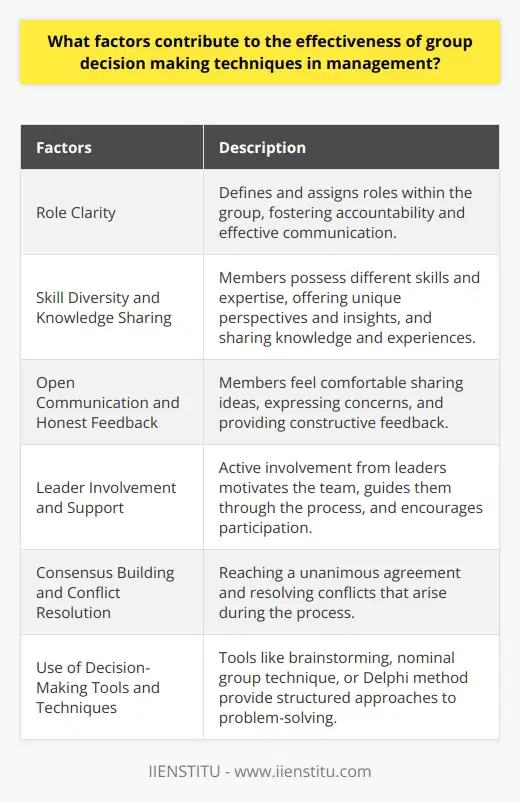
How can technology and digital tools enhance the group decision-making process in management?
Role of Digital Tools in Decision-making
Technology and digital tools play a vital role in improving group decision-making processes in management. They facilitate efficient communication, data analysis, and collaboration among team members. One way technology enhances these processes is through online communication platforms, such as Slack or Microsoft Teams. These platforms enable real-time exchanges of information and ideas, expediting the decision-making process and eliminating time wasted on scheduling meetings.
Ease of Information Access
Another advantage of digital tools is their capacity for easy information access and sharing. Cloud-based storage systems and document-sharing platforms, such as Google Drive, ensure that all relevant data, reports, and analyses are accessible to all members of the group at all times. This transparency helps to foster healthy debates and can expose potential blind spots, ultimately contributing to better-informed decisions.
Data Analysis Tools for Decision-making
Furthermore, data analysis tools, such as Microsoft Excel or Tableau, allow management teams to quickly sift through large volumes of data, identify trends, and make predictions. By utilizing these tools, management can make more informed decisions based on empirical evidence rather than intuition or subjective opinions. Consequently, this increased reliance on data can lead to more objective and well-grounded decision-making.
Shared Decision-making Tools
Additionally, group decision-making tools, such as Trello or Asana, enhance collaboration amongst team members. These platforms enable users to create and assign tasks, categorize priorities, and set deadlines. Consequently, this heightened level of organization can streamline the decision-making process and ensure that all members are aware of their specific roles and responsibilities.
Promoting Inclusivity and Diversity
Lastly, digital tools can make group decision-making more inclusive by allowing for remote participation. Video conferencing platforms, such as Zoom or Skype, enable colleagues from different geographical locations to contribute to discussions without the need for physical presence. This broader range of perspectives can enrich the decision-making process and mitigate the risk of groupthink or unconscious biases infiltrating team dynamics.
In conclusion, technology and digital tools have revolutionized the way management teams make decisions by streamlining communication, promoting collaboration, and enhancing access to data and information. By utilizing these tools, organizations can improve their decision-making processes and ultimately drive more efficient and effective outcomes.
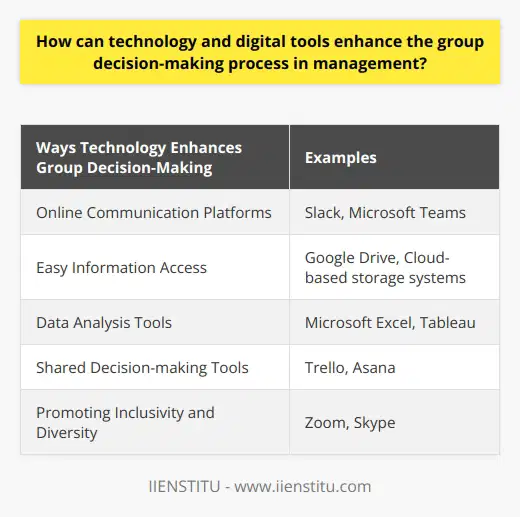
What role do leadership styles play in implementing successful group decision making within an organization?
Leadership Styles and Decision Making
In an organization, leadership styles play a crucial role in implementing successful group decision-making processes. Leaders must adopt the appropriate style to ensure collaborative and efficient decision-making within their teams. Various leadership styles impact group decision-making in different ways.
Democratic Leadership
Democratic leaders work to involve all team members in the decision-making process. By encouraging input from all group members, leaders promote a sense of ownership and commitment to the decisions made. This inclusive approach fosters a positive atmosphere and better engagement, leading to more effective and successful decisions.
Authoritative Leadership
Authoritative leaders focus on providing clear direction and vision for the group. While they may take inputs from their team members, the final decision-making power remains with the leader. This style works well when the group needs a strong sense of direction, and the leader has extensive experience in the field to make informed decisions.
Transformational Leadership
Transformational leaders inspire and motivate their team members by setting high expectations and promoting innovation. They empower employees by providing support and resources necessary for successful decision-making. This leadership style often leads to increased productivity, creativity, and job satisfaction.
Servant Leadership
Servant leaders prioritize the needs and growth of their team members, facilitating an environment that promotes shared decision-making. By building trust and fostering collaboration, servant leaders create a supportive atmosphere in which group members are more likely to voice opinions, propose solutions, and take responsibility for the decisions made.
Choosing the Right Leadership Style
The ideal leadership style largely depends on factors such as organizational culture, team dynamics, and the complexity of the problem at hand. Leaders must possess the ability to adapt their leadership style as per the context to implement successful group decision making within the organization effectively. By being flexible, conscious of team needs, and promoting an inclusive environment, leaders can significantly enhance decision-making processes, ultimately leading to the overall success of the organization.
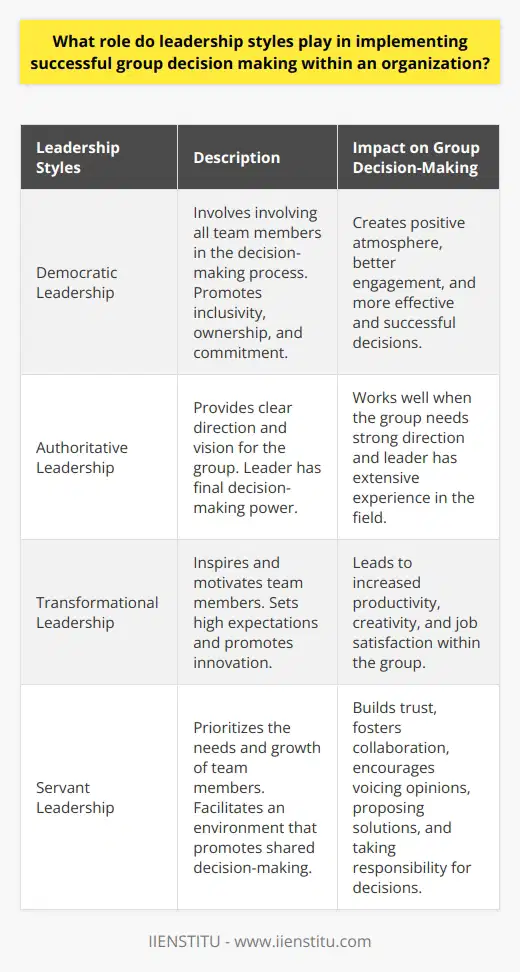
What are the four types of group decision making?
Types of Group Decision Making
Unanimous Consensus
The first type of group decision making involves the unanimous consensus of all participants. This approach is highly desirable because it reflects the complete agreement and commitment of all members to the proposed decision. However, achieving unanimity can be time-consuming and challenging, especially in large or diverse groups with varying perspectives and interests.
Majority Voting
The second type, majority voting, is commonly used in formal decision-making processes where participants cast their votes for specific options. The choice with the majority of votes is considered the group's decision. While this method is relatively fast and straightforward, it may lead to a lack of acceptance and satisfaction among members who did not support the favored choice, potentially undermining the unity of the group.
Minority Decision Making
In some instances, a small subgroup within a larger group may make decisions on behalf of the entire group. This third type, minority decision making, can occur in specialized committees or designated teams with particular expertise, knowledge, or authority in the specific topic. The larger group often delegates authority to these minority groups to streamline the decision-making process. However, this approach can exclude or marginalize the voices and opinions of the broader group members.
Consensus Building
The fourth type, consensus building, involves open dialogue, active listening, and collaboration among group members to reach a decision that is acceptable to all. This method fosters a sense of shared ownership and responsibility in the decision-making process, promoting group cohesion and harmony. Although consensus building can be time-consuming and demanding, it often results in more informed, thoughtful decisions that enjoy broader support from all members.
In conclusion, the four types of group decision making – unanimous consensus, majority voting, minority decision making, and consensus building – each have their advantages and disadvantages depending on the specific context and objectives of the group. Selecting the most appropriate decision-making approach can significantly impact the effectiveness, efficiency, and unity of the group as it pursues its goals.
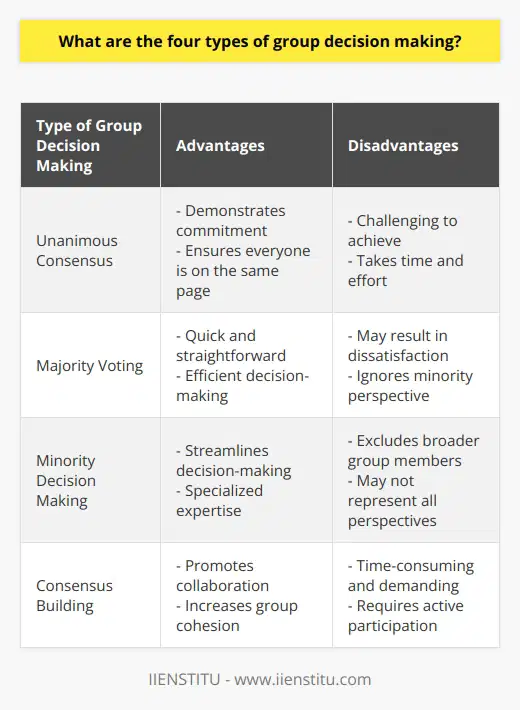
What is group decision making in principles of management?
Group Decision-Making in Management
Definition and Importance
Group decision-making refers to the process in which multiple individuals collaborate, deliberate, and discuss potential outcomes, solutions, and decisions regarding a particular issue or opportunity within an organization. It is a crucial aspect of management principles because it encourages collective intelligence, diverse perspectives, and leads to more informed and effective decisions.
Advantages and Challenges
The primary benefits of group decision-making include enhanced creativity, increased commitment, and improved accuracy in decision-making. By involving various stakeholders in the decision-making process, the organization can leverage their diverse problem-solving methods and knowledge, ultimately leading to better outcomes. Furthermore, group decision-making promotes a shared sense of ownership and responsibility, fostering a positive organizational culture.
Despite its benefits, group decision-making also poses challenges such as increased time investment, susceptibility to groupthink, and potential interpersonal conflicts. In particular, groupthink entails the phenomenon wherein group members suppress their dissenting opinions or alternative ideas in favor of conforming to the majority's views, leading to suboptimal decisions.
Techniques for Effective Group Decision-Making
To counter these challenges, managers can adopt various techniques to ensure effective group decision-making. These methods include brainstorming sessions to facilitate the generation of diverse ideas, as well as nominal group techniques that can help address potential conflicts and power dynamics within the group. In addition, the Delphi technique, relying on anonymous input from experts, can eliminate social pressure and enable unbiased decision-making.
Furthermore, managers should establish clear guidelines and expectations for group communication and behavior, encourage open and constructive feedback, and maintain a balance between individual voices and collective input. By doing so, they can harness the benefits of group decision-making while mitigating its potential drawbacks.
Conclusion
In conclusion, group decision-making is an essential aspect of management principles, allowing organizations to make more informed and effective decisions by leveraging collective knowledge and diverse perspectives. By understanding its advantages and challenges and adopting appropriate techniques, managers can optimize their teams' decision-making processes, ultimately contributing to organizational success.
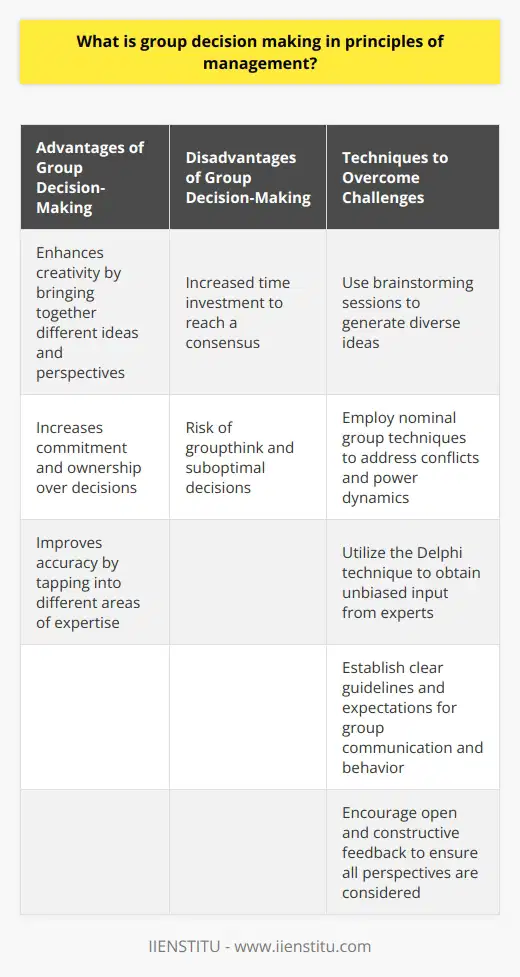
What are the three group decision making techniques?
Three Group Decision Making Techniques
**Brainstorming Method**
The first technique is brainstorming, which involves gathering various ideas from all team members to find the best possible solution. This method encourages creativity, collaboration, and free expression of thoughts without immediate judgment or criticism from other members. The purpose of brainstorming is to generate a wide array of options for the group to consider, and later, through careful discussion and evaluation, the group can narrow down and prioritize the ideas.
**Delphi Technique**
The second technique is the Delphi method, where a facilitator collects opinions and ideas from a group of subject matter experts (SMEs) through a series of questionnaires or surveys. This process is conducted anonymously, allowing each expert to express their perspective without bias or influence from others. Each round of the survey aims to further refine and clarify participants' input based on the group's feedback. The Delphi technique is particularly useful in situations where group members are geographically dispersed or when there is potential for conflict or strong personal biases.
**Nominal Group Technique (NGT)**
The third technique is the Nominal Group Technique (NGT), which combines both individual and group problem-solving processes. In the NGT, group members brainstorm ideas independently and then come together to present and discuss their contributions. Following this initial round of ideas presentation, members privately rank the solutions, and the facilitator calculates the group's overall preference by aggregating the scores. This method encourages equal participation, reduces biases or dominant personalities influencing the outcome, and allows for a structured evaluation of the proposed solutions.
In conclusion, the three group decision-making techniques - brainstorming, the Delphi technique, and the Nominal Group Technique - offer distinct advantages in various situations. By incorporating these methods appropriately, organizations can improve the quality and outcomes of their decision-making processes.

